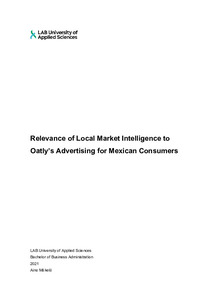Relevance of local market intelligence to Oatly's Advertising for Mexican consumers
Mäkelä, Aino (2021)
Avaa tiedosto
Lataukset:
Mäkelä, Aino
2021
Julkaisun pysyvä osoite on
https://urn.fi/URN:NBN:fi:amk-2021120924733
https://urn.fi/URN:NBN:fi:amk-2021120924733
Tiivistelmä
In today’s globalized world, standardized advertising campaigns have become increasingly common. Consequently, many global campaigns lack important components of the receiving culture, thus inflicting in less effective results. However, local insights could help brands appear more relevant to the recipients. Therefore, the thesis aims to understand the relevance of cultural differences and local market insights in advertising. Furthermore, the study aspires to determine which local insights and cultural traits could help Oatly’s advertising campaigns in the Mexican consumer market.
Deductive method is used to conduct the study. Both primary and secondary data are utilized. The theory part is based on secondary data, where local market intelligence, cultural differences, and advertising are studied. They are examined through Hall’s Iceberg Theory, Hofstede’s Cultural Dimensions, and the adaptations of De Mooij to understand the relevancy of localized advertising.
The empirical part uses primary data gathered from a research survey, which studies the way Mexican consumers react to Oatly’s advertisements. The survey includes quantitative and qualitative questions.
According to the research results, local market insights and Hofstede’s dimensions of culture apply to the Mexican market. Local market intelligence assists in the design and implementation of locally resonant advertising campaigns, and therefore help avoid cultural misunderstandings. The results signal that localized advertising is needed by the Mexican consumers. Future research is encouraged as local market intelligence is quite an unfamiliar topic. Finally, suggestions are given for studying other cultures, countries, languages, advertisement types as well as different demographic and socio-economic groups.
Deductive method is used to conduct the study. Both primary and secondary data are utilized. The theory part is based on secondary data, where local market intelligence, cultural differences, and advertising are studied. They are examined through Hall’s Iceberg Theory, Hofstede’s Cultural Dimensions, and the adaptations of De Mooij to understand the relevancy of localized advertising.
The empirical part uses primary data gathered from a research survey, which studies the way Mexican consumers react to Oatly’s advertisements. The survey includes quantitative and qualitative questions.
According to the research results, local market insights and Hofstede’s dimensions of culture apply to the Mexican market. Local market intelligence assists in the design and implementation of locally resonant advertising campaigns, and therefore help avoid cultural misunderstandings. The results signal that localized advertising is needed by the Mexican consumers. Future research is encouraged as local market intelligence is quite an unfamiliar topic. Finally, suggestions are given for studying other cultures, countries, languages, advertisement types as well as different demographic and socio-economic groups.
